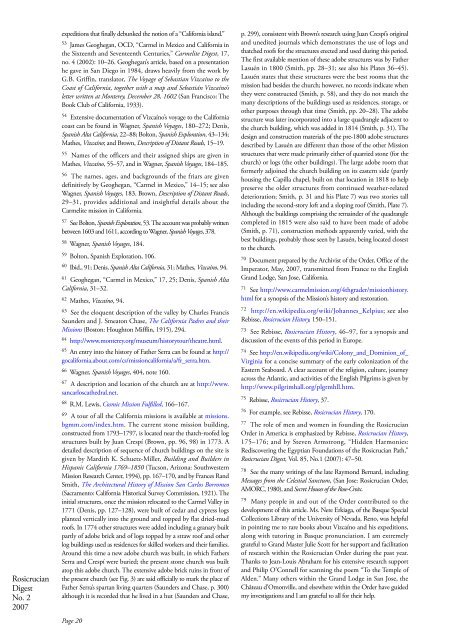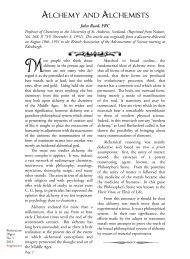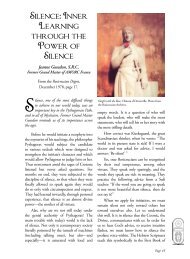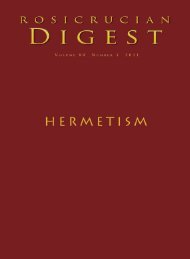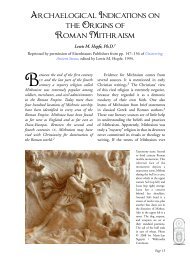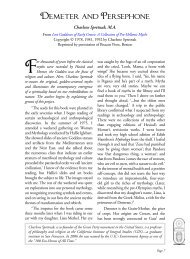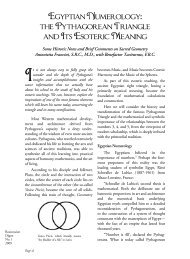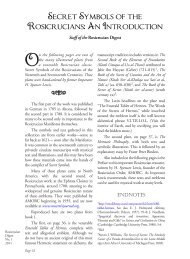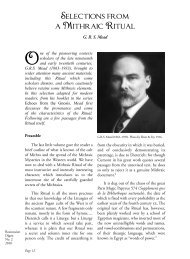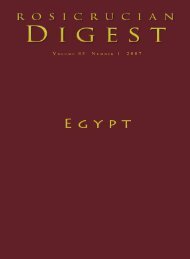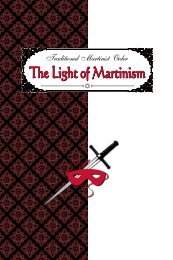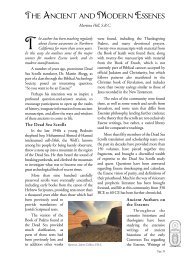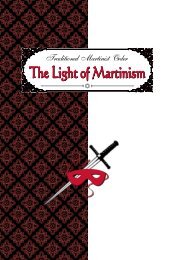Rosicrucian Digest Vol 85 Number 2 2007 - Rosicrucian Order
Rosicrucian Digest Vol 85 Number 2 2007 - Rosicrucian Order
Rosicrucian Digest Vol 85 Number 2 2007 - Rosicrucian Order
Create successful ePaper yourself
Turn your PDF publications into a flip-book with our unique Google optimized e-Paper software.
<strong>Rosicrucian</strong><br />
<strong>Digest</strong><br />
No. 2<br />
<strong>2007</strong><br />
expeditions that finally debunked the notion of a “California island.”<br />
53 James Geoghegan, OCD, “Carmel in Mexico and California in<br />
the Sixteenth and Seventeenth Centuries,” Carmelite <strong>Digest</strong>, 17,<br />
no. 4 (2002): 10–26. Geoghegan’s article, based on a presentation<br />
he gave in San Diego in 1984, draws heavily from the work by<br />
G.B. Griffin, translator, The Voyage of Sebastian Vizcaíno to the<br />
Coast of California, together with a map and Sebastián Vizcaíno’s<br />
letter written at Monterey, December 28, 1602 (San Francisco: The<br />
Book Club of California, 1933).<br />
54 Extensive documentation of Vizcaíno’s voyage to the California<br />
coast can be found in Wagner, Spanish Voyages, 180–272; Denis,<br />
Spanish Alta California, 22–88; Bolton, Spanish Exploration, 43–134;<br />
Mathes, Vizcaíno; and Brown, Description of Distant Roads, 15–19.<br />
55 Names of the officers and their assigned ships are given in<br />
Mathes, Vizcaíno, 55–57, and in Wagner, Spanish Voyages, 184–1<strong>85</strong>.<br />
56 The names, ages, and backgrounds of the friars are given<br />
definitively by Geoghegan, “Carmel in Mexico,” 14–15; see also<br />
Wagner, Spanish Voyages, 183. Brown, Description of Distant Roads,<br />
29–31, provides additional and insightful details about the<br />
Carmelite mission in California.<br />
57 See Bolton, Spanish Exploration, 53. The account was probably written<br />
between 1603 and 1611, according to Wagner, Spanish Voyages, 378.<br />
58 Wagner, Spanish Voyages, 184.<br />
59 Bolton, Spanish Exploration, 106.<br />
60 Ibid., 91; Denis, Spanish Alta California, 31; Mathes, Vizcaíno, 94.<br />
61 Geoghegan, “Carmel in Mexico,” 17, 25; Denis, Spanish Alta<br />
California, 31–32.<br />
62 Mathes, Vizcaíno, 94.<br />
63 See the eloquent description of the valley by Charles Francis<br />
Saunders and J. Smeaton Chase, The California Padres and their<br />
Missions (Boston: Houghton Mifflin, 1915), 294.<br />
64 http://www.monterey.org/museum/historytour/theatre.html.<br />
65 An entry into the history of Father Serra can be found at http://<br />
gocalifornia.about.com/cs/missioncalifornia/a/fr_serra.htm.<br />
66 Wagner, Spanish Voyages, 404, note 160.<br />
67 A description and location of the church are at http://www.<br />
sancarloscathedral.net.<br />
68 R.M. Lewis, Cosmic Mission Fulfilled, 166–167.<br />
69 A tour of all the California missions is available at missions.<br />
bgmm.com/index.htm. The current stone mission building,<br />
constructed from 1793–1797, is located near the thatch-roofed log<br />
structures built by Juan Crespí (Brown, pp. 96, 98) in 1773. A<br />
detailed description of sequence of church buildings on the site is<br />
given by Mardith K. Schuetz-Miller, Building and Builders in<br />
Hispanic California 1769–1<strong>85</strong>0 (Tucson, Arizona: Southwestern<br />
Mission Research Center, 1994), pp. 167–170, and by Frances Rand<br />
Smith, The Architectural History of Mission San Carlos Borromeo<br />
(Sacramento: California Historical Survey Commission, 1921). The<br />
initial structures, once the mission relocated to the Carmel Valley in<br />
1771 (Denis, pp. 127–128), were built of cedar and cypress logs<br />
planted vertically into the ground and topped by flat dried-mud<br />
roofs. In 1774 other structures were added including a granary built<br />
partly of adobe brick and of logs topped by a straw roof and other<br />
log buildings used as residences for skilled workers and their families.<br />
Around this time a new adobe church was built, in which Fathers<br />
Serra and Crespí were buried; the present stone church was built<br />
atop this adobe church. The extensive adobe brick ruins in front of<br />
the present church (see Fig. 3) are said officially to mark the place of<br />
Father Serra’s spartan living quarters (Saunders and Chase, p. 300)<br />
although it is recorded that he lived in a hut (Saunders and Chase,<br />
Page 20<br />
p. 299), consistent with Brown’s research using Juan Crespí’s original<br />
and unedited journals which demonstrates the use of logs and<br />
thatched roofs for the structures erected and used during this period.<br />
The first available mention of these adobe structures was by Father<br />
Lasuén in 1800 (Smith, pp. 28–31; see also his Plates 36–45).<br />
Lasuén states that these structures were the best rooms that the<br />
mission had besides the church; however, no records indicate when<br />
they were constructed (Smith, p. 58), and they do not match the<br />
many descriptions of the buildings used as residences, storage, or<br />
other purposes through that time (Smith, pp. 20–28). The adobe<br />
structure was later incorporated into a large quadrangle adjacent to<br />
the church building, which was added in 1814 (Smith, p. 31). The<br />
design and construction materials of the pre-1800 adobe structures<br />
described by Lasuén are different than those of the other Mission<br />
structures that were made primarily either of quarried stone (for the<br />
church) or logs (the other buildings). The large adobe room that<br />
formerly adjoined the church building on its eastern side (partly<br />
housing the Capilla chapel, built on that location in 1818 to help<br />
preserve the older structures from continued weather-related<br />
deterioration; Smith, p. 31 and his Plate 7) was two stories tall<br />
including the second-story loft and a sloping roof (Smith, Plate 7).<br />
Although the buildings comprising the remainder of the quadrangle<br />
completed in 1815 were also said to have been made of adobe<br />
(Smith, p. 71), construction methods apparently varied, with the<br />
best buildings, probably those seen by Lasuén, being located closest<br />
to the church.<br />
70 Document prepared by the Archivist of the <strong>Order</strong>, Office of the<br />
Imperator, May, <strong>2007</strong>, transmitted from France to the English<br />
Grand Lodge, San Jose, California.<br />
71 See http://www.carmelmission.org/4thgrader/missionhistory.<br />
html for a synopsis of the Mission’s history and restoration.<br />
72 http://en.wikipedia.org/wiki/Johannes_Kelpius; see also<br />
Rebisse, <strong>Rosicrucian</strong> History, 150–151.<br />
73 See Rebisse, <strong>Rosicrucian</strong> History, 46–97, for a synopsis and<br />
discussion of the events of this period in Europe.<br />
74 See http://en.wikipedia.org/wiki/Colony_and_Dominion_of_<br />
Virginia for a concise summary of the early colonization of the<br />
Eastern Seaboard. A clear account of the religion, culture, journey<br />
across the Atlantic, and activities of the English Pilgrims is given by<br />
http://www.pilgrimhall.org/plgrmhll.htm.<br />
75 Rebisse, <strong>Rosicrucian</strong> History, 37.<br />
76 For example, see Rebisse, <strong>Rosicrucian</strong> History, 170.<br />
77 The role of men and women in founding the <strong>Rosicrucian</strong><br />
<strong>Order</strong> in America is emphasized by Rebisse, <strong>Rosicrucian</strong> History,<br />
175–176; and by Steven Armstrong, “Hidden Harmonies:<br />
Rediscovering the Egyptian Foundations of the <strong>Rosicrucian</strong> Path,”<br />
<strong>Rosicrucian</strong> <strong>Digest</strong>, <strong>Vol</strong>. <strong>85</strong>, No.1 (<strong>2007</strong>): 47–50.<br />
78 See the many writings of the late Raymond Bernard, including<br />
Messages from the Celestial Sanctum, (San Jose: <strong>Rosicrucian</strong> <strong>Order</strong>,<br />
AMORC, 1980), and Secret Houses of the Rose-Croix.<br />
79 Many people in and out of the <strong>Order</strong> contributed to the<br />
development of this article. Ms. Nere Erkiaga, of the Basque Special<br />
Collections Library of the University of Nevada, Reno, was helpful<br />
in pointing me to rare books about Vizcaíno and his expeditions,<br />
along with tutoring in Basque pronunciation. I am extremely<br />
grateful to Grand Master Julie Scott for her support and facilitation<br />
of research within the <strong>Rosicrucian</strong> <strong>Order</strong> during the past year.<br />
Thanks to Jean-Louis Abraham for his extensive research support<br />
and Philip O’Connell for scanning the poem “To the Temple of<br />
Alden.” Many others within the Grand Lodge in San Jose, the<br />
Château d’Omonville, and elsewhere within the <strong>Order</strong> have guided<br />
my investigations and I am grateful to all for their help.


